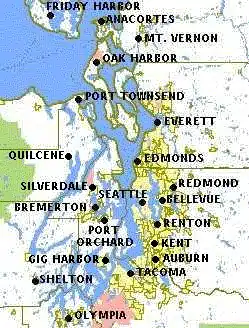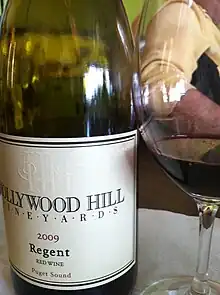Puget Sound AVA
The Puget Sound AVA is an American Viticultural Area in western Washington State. It is the only AVA in the state of Washington that is located west of the Cascade Mountains.[3][4]
| Wine region | |
 | |
| Type | American Viticultural Area |
|---|---|
| Year established | 1995[1] |
| Country | United States |
| Part of | Washington |
| Growing season | 210 days |
| Climate region | Temperate, Maritime |
| Precipitation (annual average) | 15 inches (38 cm) to 60 inches (152 cm) |
| Soil conditions | Glacial Till over a semi-permeable cemented subsoil |
| Size of planted vineyards | 100 acres (40 ha) |
| Grapes produced | Madeleine Angevine, Madeleine Sylvaner, Müller-Thurgau, Pinot gris, Pinot noir, Siegerrebe[2] |
| No. of wineries | 12 |
| Wine produced | Varietal, Sparkling wine, Dessert wine |
Geography and climate

The AVA encompasses the entire Puget Sound area from the Canada–US border to just south of Olympia.[5]
Rainfall in the Puget Sound AVA ranges from 15 inches (38 cm) to 60 inches (152 cm) annually, which is similar to many European grape growing areas and the Willamette Valley AVA in Oregon. Most of that rainfall occurs in the winter time. Summers are mild, sunny and dry. Irrigation is a necessity in some of the drier locations. The AVA is suited to cool climate varieties such as Madeleine Angevine, Madeline Sylvaner, Müller-Thurgau and Siegerrebe with some clonal varieties of Pinot noir and Pinot gris, Chardonnay and Melon de Bourgogne growing well in warmer locations. Many new varieties showed promise during tests at the Washington State University Mount Vernon Agricultural Research Station circa 2005. Those include Regent, St. Laurent, Zweigelt, Dornfelder and Garanoir.[6] In 2019 we're starting to see several of these varieties are showing up in tasting rooms in the area.
The region is almost entirely within hardiness zone 8b.
History
One of the earliest recorded plantings in the Puget Sound area was done in 1872 by an American Civil War veteran named Lambert Evans on Stretch Island, near modern-day Allyn-Grapeview. Evans planted several varieties of Vitis labrusca there.[7] There are still a few of these "Island Belle" vines surviving (2019) and Hoodsport Winery has produced a wine from them with that name for decades.[8]
Bainbridge Island Vineyard and Winery was established in 1977, their Founder Gerard Bentryn is credited with being the first to establish Vitis vinifera grapes in the Puget Sound area. Bentryn authored and established the definition of the Puget Sound AVA in 1995. It is the 4th AVA established in Washington State.[9] Bentryn is also credited with being instrumental in bringing many of the cool climate varietals in common use today; he worked with Dr. Norton at Washington State University and had them imported from Saanich Farm Experimental Station in Canada, Geisenheim Grape Breeding Institute in Germany, and others.
Wineries
Although the Puget Sound AVA contains many wineries, most bring in grapes from Eastern Washington. As of 2019 there are 18 wineries producing wines from Puget Sound AVA grapes.[4]
References
- "§ 9.151 Puget Sound" (Title 27: Alcohol, Tobacco and Firearms; Part 9 — American Viticultural Areas; Subpart C — Approved American Viticultural Areas). Code of Federal Regulations. Retrieved January 30, 2008.
- "Puget Sound (AVA): Appellation Description". Appellation America. 2007. Archived from the original on May 16, 2008. Retrieved January 30, 2008.
- Parker, Tom (September 1, 2002). Discovering Washington Wines: An Introduction to One of the Most Exciting Premium Wine Regions. Raconteurs Press. p. 30. ISBN 0-9719258-5-2.
- "Puget Sound Wine Growers Assoc".
- Parker 2002, p. 49
- Moulton, Gary A.; King, Jacqueline (2001). "Growing Wine Grapes in Maritime Western Washington" (EM068E). Washington State University Extension Publishing.
{{cite journal}}: Cite journal requires|journal=(help) - Parker 2002, p. 7
- "Hoodsport Winery". 2020.
- "Puget Sound AVA Profile" (PDF). Washington State AVAs. 2017.